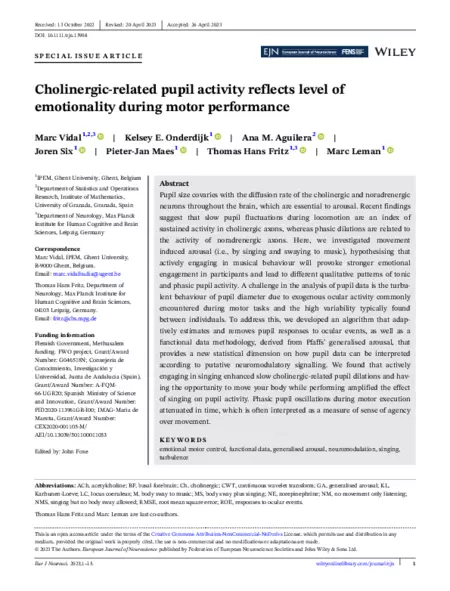Author version | Version of record
Publication type: Journal Articles
Abstract: Pupil size covaries with the diffusion rate of the cholinergic and noradrenergic neurons throughout the brain, which are essential to arousal. Recent findings suggest that slow pupil fluctuations during locomotion are an index of sustained activity in cholinergic axons, whereas phasic dilations are related to the activity of noradrenergic axons. Here, we investigated movement induced arousal (i.e., by singing and swaying to music), hypothesising that actively engaging in musical behaviour will provoke stronger emotional engagement in participants and lead to different qualitative patterns of tonic and phasic pupil activity. A challenge in the analysis of pupil data is the turbulent behaviour of pupil diameter due to exogenous ocular activity commonly encountered during motor tasks and the high variability typically found between individuals. To address this, we developed an algorithm that adaptively estimates and removes pupil responses to ocular events, as well as a functional data methodology, derived from Pfaffs' generalised arousal, that provides a new statistical dimension on how pupil data can be interpreted according to putative neuromodulatory signalling. We found that actively engaging in singing enhanced slow cholinergic-related pupil dilations and having the opportunity to move your body while performing amplified the effect of singing on pupil activity. Phasic pupil oscillations during motor execution attenuated in time, which is often interpreted as a measure of sense of agency over movement.
Cite this article:
@article{https://doi.org/10.1111/ejn.15998,
author = {Vidal, Marc and Onderdijk, Kelsey E. and
Aguilera, Ana M. and Six, Joren and
Maes, Pieter-Jan and Fritz, Thomas Hans
and Leman, Marc},
doi = {https://doi.org/10.1111/ejn.15998},
journal = {European Journal of Neuroscience},
title = {Cholinergic-related pupil activity reflects level of
emotionality during motor performance},
url = {https://onlinelibrary.wiley.com/doi/abs/10.1111/ejn.15998}
}

